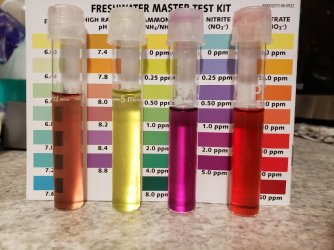Let's talk about nitrite and nitrate and testing for just a bit.
When there is nitrite in the water and insufficient chloride level, the nitrite can get inside the fish. When this happens it prevents the blood from holding oxygen. Once there is no longer any nitrite in the water it takes aout 12 -24 hours for what is in the fish to be gone. In more severe cases it can take longer.
In most cases where there is nitrite in a tank it is a cycling issue. One of the thing to know about this all is that the bacteria in tanks which handle nitrite are Nitrospira. It was discovered that this type of bacteria is actually able to process ammonia straight through to nitrate. So we tend to have both ammonia oxidizers which make nitrite from ammonia and then the nitrospira which can be turning ammonia to nitrate.
Testing for nitrate is a difficult challenge. So the way that hobby test kits work is that they convert nitrate to nitrite and then they measure that. This means when once has nitrite in a tank it will affect the results of a nitrate test.
Now, lets assume that fish in a tank are suffering from nitrite poisoning. Normally it will take some time to build up the bacteria for handling nitrite even as more is being produced. Water changes slow cycling. So they should be avoided as long as possible. How and when to change water depends on two factors, the first is whether fish are present and the second is when ammonia or nitrite levels are too high to encourage the desired strains of bacteria. Too much ammonia or nitrite can stall a cycle.
The bigger problems are when there are fish in the tank as opposed to when we are doing a fishless cycle. As long as there is mnitrite in the water it will act to keep nitrite from entering a fish and doing it's harm. What science does know is that chloride blocks the nitrite from entering the fish. In fact science states that any study of nitrite and fish must include data on chloride levels or else the study is worthless.
What the presence of chloride does is to protect the fish from the nitrite while still allowing the bacteria that will multiply from nitrite being present can still use it. By not changing water for nitrie levlels but protecting the fish with chloride means that the bacteria needed will multiply at the fastest rate they can and that will solve the cause faster.
Just changing water does not do the trick when nitrite is invilved. After you change the water there is still nitrite in the fish. Even if we can get the nitrite level to 0, it will still be about a day for the nitrite to leave ther blood and for it to resume carrying oxygen. Unfortunately, when it comes to ammonia we cannot block it and water changes or detoxifying the ammonia are the only options. The problem with detoxifying when it is a cycling issue slows the cycle as well. This is because the detox converts the ammonia to ammonium whiohc is less toxic. But the bacteria cannot process ammonium with the same efficiency as ammonia. So the bacteria will take longer to reproduce in response to excess ammonia.
Lastly. the signs of nitrate poisoning are similar to those of nitrite. The big difference is that it takes much higher levels of nitrate to cause similar effects. Lower levels of nitrate can cause other forms of harm but are rarely fatal for most fish once they are no longer very young.
Finally, research has shown that when it comes to either ammonia or nitrite, difference fish species are more or less able to handle it before it becomes a real issue. So in a tank with multiple species it is not unreasonable for some to be effected before other show any symptoms. But once levels are high enough and/or for long enough, it will effect them all.
Two last notes re nitrite poisoning. First, does not turn the gills red it turns them brownish. Nitrite poisoning is often called brown blood disease. Second, the amount of salt needed to get the requisite concentration of chloride into the water is pretty low. Most fish can tolerate it. The alternative treatment is much more expensive and is be calcium chloride.
Also, it is difficult to read your test results because it appears as if the light sources is to the right of the card and vile. It is best to have the light source coming from behind you when reading or photographing the results.
edited for spellin and typos



